#Position Velocity Sensors
Explore tagged Tumblr posts
Text
Unveiling the Power of Position Velocity Feedback Transmitter Systems in Modern Industries

Introduction: The Importance of Position and Velocity Feedback Systems in Precision Control
Position and velocity feedback transmitter systems are integral to industries that demand high-precision control and motion tracking. These systems are employed to monitor the position and velocity of moving objects in real-time, providing critical data for automated operations. The evolution of these systems has been significant, with advancements in technology enabling more compact, accurate, and reliable feedback mechanisms that drive automation, robotics, aerospace, automotive, and healthcare applications.
With the global shift towards increased automation, the demand for such systems is on the rise. Industries across the board require precise control of machinery, vehicles, and robots to enhance performance, improve safety, and optimize productivity. The growing need for smart manufacturing, autonomous vehicles, and medical robotics underscores the vital role these systems play in modern industries. Despite some challenges, such as high upfront costs and integration complexities, the long-term benefits of precision, efficiency, and reliability outweigh these hurdles.
Request Sample Report PDF (including TOC, Graphs & Tables): https://www.statsandresearch.com/request-sample/40604-global-position-velocity-feedback-transmitter-systems-market
Position Velocity Feedback Transmitter Systems Market Dynamics: Drivers, Challenges, and Opportunities
Drivers of Growth
The Position Velocity Feedback Transmitter Systems market is experiencing robust growth driven by several key factors:
Advancements in Automation and Robotics: Industries across manufacturing, automotive, and aerospace are increasingly adopting automation technologies. These systems allow for faster, more accurate control, driving the need for precise position and velocity feedback.
Technological Advancements in Sensors: Innovations in sensor technology, particularly in digital systems, are facilitating the development of more accurate and miniaturized position velocity feedback systems. The integration of Internet of Things (IoT) technologies is making these systems smarter and more adaptable, driving their adoption in industries such as healthcare, smart manufacturing, and autonomous vehicles.
The Rise of Industry 4.0: Industry 4.0 technologies are revolutionizing production lines, with automation and data-driven decisions at their core. Position velocity feedback systems play a critical role in enabling smarter, more efficient manufacturing processes.
Emerging Applications in Healthcare and Autonomous Vehicles: In healthcare, robotic surgeries and diagnostics systems demand highly accurate motion control, while autonomous vehicles require precise feedback systems for safe operation. Both sectors are driving significant demand for position and velocity feedback systems.
Get up to 30% Discount: https://www.statsandresearch.com/check-discount/40604-global-position-velocity-feedback-transmitter-systems-market
Challenges to Position Velocity Feedback Transmitter Systems Market Adoption
Despite the promising growth, several barriers could slow the widespread adoption of position velocity feedback transmitter systems:
High Initial Investment Costs: The cost of acquiring and integrating high-precision position velocity feedback systems can be prohibitive, especially for small and medium-sized enterprises (SMEs). High upfront costs can deter organizations from upgrading or adopting these systems, limiting market expansion.
Complexity of System Integration: Integrating new feedback systems with existing infrastructure and machinery can be complex and time-consuming, especially in industries that have legacy systems. This complexity increases the time to market and may discourage immediate adoption.
Specialized Training Requirements: The operation, calibration, and maintenance of advanced position velocity feedback systems require highly specialized knowledge and skills. The shortage of skilled labor in these fields may hinder growth, particularly in developing regions.
Key Opportunities
Several emerging trends present substantial opportunities for the growth of the position velocity feedback transmitter systems market:
Smart Manufacturing: As manufacturing processes become increasingly automated, there is a growing demand for position velocity feedback systems to enhance productivity and reduce human error. These systems are integral to improving the efficiency of production lines and ensuring consistent product quality.
Healthcare Robotics: Surgical robots, diagnostic devices, and rehabilitation technologies require real-time motion control. The healthcare sector’s increasing reliance on these technologies provides a substantial opportunity for the growth of high-precision position feedback systems.
Autonomous Vehicles: The rapid development of autonomous vehicles (AVs) hinges on accurate motion tracking and feedback systems for safe navigation. As the demand for AVs increases, so too will the demand for position and velocity feedback transmitters that ensure precise vehicle control.
Position Velocity Feedback Transmitter Systems Market Segmentation and Analysis
By Type
The position velocity feedback transmitter systems market can be divided into two key types:
Position Feedback Transmitter: This sub-segment is expected to dominate the market, driven by the increasing demand for precision in industrial automation applications. Position feedback transmitters provide accurate location tracking, ensuring the correct placement of components in automated systems.
Velocity Feedback Transmitter: While this segment is smaller, it is growing rapidly due to the need for precise speed control in applications such as robotics, aerospace, and automotive industries.
By Technology
Analog Systems: While still in use, analog systems are being increasingly replaced by more sophisticated digital feedback systems that offer greater accuracy and scalability.
Digital Systems: Dominating the market, digital systems provide real-time, highly accurate feedback for a range of applications, particularly in industries like automotive, aerospace, and healthcare. The continued innovation in sensor technology and integration with IoT is expected to fuel further growth in this segment.
By Application
The demand for position and velocity feedback systems spans a variety of industries:
Industrial Automation: Expected to maintain the largest market share, industrial automation continues to be the leading driver of demand for precise motion control systems. These systems are integral to ensuring the accuracy and speed of machinery in sectors such as manufacturing and material handling.
Aerospace and Defense: Aerospace applications require high-precision feedback systems for tasks such as flight control, navigation, and satellite positioning.
Automotive: As automotive systems become more automated, the demand for position and velocity feedback systems grows. These systems ensure precise vehicle control in autonomous and semi-autonomous driving technologies.
Energy: The energy sector, particularly in renewable energy systems, requires high-performance motion control to optimize energy production and distribution.
By Region
The market is geographically diverse, with distinct growth patterns across various regions:
North America: Dominating the market, North America is poised to continue leading the position velocity feedback transmitter systems market due to its advanced industrial sectors, including aerospace and automotive.
Asia-Pacific: The Asia-Pacific region is expected to witness the highest growth rate, driven by rapid industrialization and the increasing adoption of automation technologies in countries like China and India.
Europe: Europe’s strong automotive and industrial automation sectors will continue to contribute to the growth of this market.
Latin America and Middle East & Africa: While smaller markets, the demand for these systems is expected to rise as industries in these regions embrace automation and robotics.
Position Velocity Feedback Transmitter Systems Market Competitive Landscape
Key Players
The market for position velocity feedback transmitters is highly competitive, with several industry leaders at the forefront:
Pepperl+Fuchs: Known for its next-generation sensors, Pepperl+Fuchs continues to innovate with solutions tailored to the needs of the automotive and industrial automation sectors. The company launched new high-performance sensors aimed at enhancing precision in harsh industrial environments in 2024.
Temposonics: Specializing in digital feedback systems, Temposonics has made significant strides in the robotics and aerospace sectors. Their advanced systems offer real-time position and velocity tracking, catering to industries that demand high-speed and high-accuracy solutions.
Other Key Players: Other companies in this market include Balluff, Siemens, and Honeywell, each offering various solutions across different applications, from industrial automation to healthcare.
Emerging Trends in Competition
Integration of IoT: Manufacturers are increasingly integrating IoT technologies into their position velocity feedback systems to enhance data collection, improve connectivity, and enable predictive maintenance.
Customization and Tailored Solutions: Companies are focusing on providing customized solutions for specific industries to cater to the unique needs of sectors such as automotive, aerospace, and healthcare.
Sustainability Initiatives: With growing environmental concerns, companies are developing energy-efficient systems that not only meet performance requirements but also adhere to sustainable production practices.
Purchase Exclusive Report: https://www.statsandresearch.com/enquire-before/40604-global-position-velocity-feedback-transmitter-systems-market
Conclusion:
The Position Velocity Feedback Transmitter Systems Market is on a rapid growth trajectory, driven by advancements in automation, robotics, and sensor technologies. The demand for high-precision motion control systems is intensifying as industries seek to improve efficiency, safety, and productivity. Despite challenges such as high initial costs and integration complexities, the opportunities presented by emerging applications in healthcare, autonomous vehicles, and smart manufacturing are substantial.
With continued innovation and a focus on integration with IoT and digital technologies, the market is well-positioned for long-term expansion. As the industrial landscape continues to evolve, the role of position and velocity feedback systems will be pivotal in shaping the future of automation and precision control across various sectors.
Our Services:
On-Demand Reports: https://www.statsandresearch.com/on-demand-reports
Subscription Plans: https://www.statsandresearch.com/subscription-plans
Consulting Services: https://www.statsandresearch.com/consulting-services
ESG Solutions: https://www.statsandresearch.com/esg-solutions
Contact Us:
Stats and Research
Email: [email protected]
Phone: +91 8530698844
Website: https://www.statsandresearch.com
#Position Velocity Feedback Transmitter Systems Market#Position Feedback Systems#Velocity Feedback Transmitters#Automation#Industrial Automation#Motion Control Systems#Precision Motion Tracking#Position and Velocity Sensors#Digital Feedback Systems#Robotics#Aerospace Industry#Autonomous Vehicles#Healthcare Robotics#Smart Manufacturing#Industrial Robotics#Sensor Technology#Motion Control#Market Growth#Industry 4.0#Digital Position Sensors#Automotive Automation#IoT-enabled Feedback Systems#High-Precision Transmitters#Real-time Position Feedback#Aerospace Sensors#Automation Trends#Smart Manufacturing Systems#Position Velocity Sensors#Market Analysis#Precision Control Systems
1 note
·
View note
Text



MITEE 8 (1995), by David Otten, MIT. MITEE Mouse 8 came 2nd in the 16th All Japan Micromouse Competition in 1995, losing to Ssing Ssing 3. The video is an excerpt from "UK Micromouse 1998."
"One of the fastest micromice, MITEE 8 by David Otten of MIT, contains two DC motors with encoders, six 225mAh NiCd rechargeables and weights about 200 grams. Side sensors consist of infrared emitter and a PSD sensor, whose output is proportional to the distance independent of reflectivity of the surface." – A Survey of Robotic Competitions, by Richard Balogh.
"Triangulation sensors [were] pioneered by David Otten. These sensors consist of a narrow beam emitter coupled with a Position Sensitive Detector (PSD) which has a lens in front of it. The idea is that the emitter illuminates a spot on the wall and then the lens images the spot on to the PSD. As the distance between the sensor and the wall changes, the location of the spot on the PSD moves. By determining the location of the spot on the PSD, you can tell how far the wall is from the sensor. What is super nice about this approach is that it is wall reflection intensity insensitive. The downside is that it requires precise location of the emitter, detector, lens and two trans-impedance amplifiers per PSD." – Micromouse Sensor Design, by Harjit Singh.
"Mitee Mouse 8 is another micromouse from David Otten of MIT in collaboration with Tony Caloggero. It is driven by DC motors and gets its power from six 225mAHr NiCd batteries. Total weight is about 200g. The sensors are side-looking and use an assembly consisting of an IR emitter, lenses and hamamatsu position sensitive detectors. A spot of light is created on the wall and its image focussed onto the PSD. The result is an output that should be independent of the reflectivity of the walls and proportional only to distance. Demonstrated linearity and range of these sensors is remarkable. The underside view show encoder disks attached to the wheels for velocity feedback. Separate encoders 9with the small black tyres) are mounted just inboard of the drive wheels for distance/position sensing." – Pete Harrison.
#cybernetics#robot#micromouse#UK Micromouse 1998#MIT#MITEE#1995#All Japan Micromouse Competition#16th All Japan Micromouse Competition#maze solvers
24 notes
·
View notes
Text
WLF-Xb-KNT Wolf Knight
Description:
The WLF-Xb-KNT Wolf Knight is highly specialised one of a kind mech made from primarily the chassis of a Black Knight and a number of parts from a Battlemaster. Made to the whims of a mechwarrior with a strange idea with some mechtech experience, the Wolf Knight was constructed allegedly from a dream, that was then committed to paper, explored and executed. Its primary purpose is to be an upgraded Black Knight with heavier armour, jump jets and extensive re-engineering of the Black Knights interior and sensor suite. The interior was remade to fit a powerful Extra-Light engine. The chassis and frame was remodeled extensively and changing to a more common frame model of pieces of changed BL-7-KNT Black Knight pieces and that of a BLR-1G Battlemaster. Despite its Frankenmech design, the focus on off the shelf parts allows the Wolf Knight an ease of access for repairs and maintenance to a surprising degree despite the heavy modifications. The most taxing parts are its dual Myomer and servo system and the cockpit to sensor connections. The refit process documented the notes of these two extensively but nevertheless requires a very qualified engineer to repair and maintain. It makes extensive use of Triple Strength Myomers that run through the mech coupled with finely and highly tuned actuators, calibrated after the pilot's movements, the Wolf Knight can swing the great blade's motions in its hand with tilts, flicks and even whips in its attacks. This is made possible with a secondary Myomer system that works on tandem with the more powerful one, giving increased agility and precision. Lastly this secondary Myomer system is backed up and tied into an integrated hydraulic servo system with the fibres themselves attached to limit switches for a natural pullback and resistance. The practical nature or battlefield application was contentious even by the refitting engineers but it was found difficult to argue against the one placing the order. One of its most curious features and the namesake is the re-engieering of the sensor suite of the Black Knight. It uses similar principles as the originals Beagle Active Probe system which uses the small laser to scan. Instead it has a second sensor tower, giving it two "ears" on the Knight helmet. Together with the pilot harness this is called the High Oscilation Wave-Length system or H.O.W.L. for short. It functions by generating pulses and frequencies through the heart rate monitor and neurohelmet's brain wave readings. Which in turn create an algorithm that is impossible to predict or even anticipate for a computer. This forms the basis of the skip-frequencies used in the sensor system in its pulses. The effect shifts the Mech's position by one to two meters between pulses on hostile sensors, slightly distorting the Wolf-Knight position, velocity and direction. Even skilled combatants can be caught unaware of their mech suddenly shifting the targeting to compensate. Leading to glancing shots. However the H.O.W.L. system distorts command and control communication over long distance, forcing it rely on short wave range bands. For this reason, it is usually only active during active combat operations in order to allow for strategic coordination. This, along with the precise movements of the arms is achieved by a specially made cockpit. Rather than the usual joystick configuration, the mechwarrior wears a harness that can mimic arm movements of the pilot. In addition it keeps track of the pilot's vitals and uses these together with the helmet to modify the frequencies of of the sensor suite and probe. The harness is heavy to move and is is wholly integrated with the neurohelmet and cockpit at large and tailored for a single individual and does not interact well with ejections.
Armament:
The Wolf Knight wields a large sword in the right, though functionally is follows the design principles of Fedcom-era hatchets. Otherwise the loadout is very similar to that of a Black Knight. A Lord's Light 2 rather than the royal versions' Kinslaughter ERPPC in the left arm allows for long range sniping with an original Maxell DT medium laser mounted under the main cannon. It is supported by two Magna Mk III large lasers as shoulder cannons along with parts of the housing used for a Rifleman. Instead of the the original torso mounted McCorkel mounted in order to make space for the new internal systems. Using parts and housing from a a Catapult on each side of the torso is a pair of Martell Medium Lasers and Omnicron 1000 Small lasers. Allowing the Wolf Knight to brawl with to a similar degree as a standard Black Knight.
Sixteen Double heat sinks allows the Wolf Knight to remain at range and fight without significant overheating. Once it gets close and pounces with the shorter range lasers it can easily activate the full potential of the Triple Strength Myomer system.
Inside the chest of the Wolf Knight however remains the Beagle Active Probe from which the black knight was noted for carrying. It has been wired to a Ceres Metals model 666 Communication system that connects into the Beagle Active Probe together with the original TransComm Beta targeting system.
The engine is connect to a RedLine-F Series Outland Supercharger system that allows the Wolf Knight to pounce on targets with the blade. Four Chillton model 600 Jump jets give it an extra level of mobility. However the XL is a weak point in long engagements where endurance becomes the dominating factor as a single torso side being blown apart would stall the engine.

Made in blender by kitbashing a number of things together.
28 notes
·
View notes
Text
Telemetry and Data Analysis
Alright, so i thought I would dive into telemetry because it is such an important part of F1 that I feel most people don't entirely understand. I will explain what it is, how it is gathered how it is used, and other such info. Enjoy!
So, as most people know F1 cars are absolutely covered in sensors, Hundreds, in fact, and their main purpose is to gather as much data as possible form the car, transmit it to the bit wall, and be used for strategic decisions and also to keep an eye on the health of the car.
Major Sensors
Engine/Power Unit: These sensors measure temperature, pressure fuel flow, and RPMs.
Tires: These sensors help keep track of tire life, temperature, and pressure.
Brakes: These sensors keep track of brake temperature and life.
Suspension: These sensors measure the vertical movement, stiffness, and ground clearance of the car.
GPS and Accelerometers: These sensors track the cars position, velocity, acceleration, and the G-forces it is experiencing.
Steering and Throttle Position: These sensors track driver input and typical behavior in race.
Telemetry System: This is the system inside of the car that gathers all of the data from these various sensors and sends them back to the pit wall.
Types of Data Collected:
Performance Data: These are metrics like lap time, sector times, speed trap data, and acceleration. Helps drivers identify areas on track they are gaining or losing time, and is perhaps the data they pay the most attention to in regards to their own performances. A really good driver will be constantly analyzing performance data and altering the way they drive around the areas they lose time on track. This can also lead to major driver coaching in race, where for example the race engineer will advise on areas they need to pick up speed in order to maintain momentum and either keep or gain position
Health and Reliability Data: This data is things like engine health, brake temperature, fuel pressure, and oil levels. It helps them identify any issues that need handling mid race. for example if they see that their brake temperature is getting too high, they will alter the brake cooling ducts or have the driver change their braking style a little to help cool down. They also keep track of this data across the season so when they did upgrades or fixes, they can address consistent problem areas.
Grip and Environmental Data: This data surrounds things like tire wear, temperature, grip levels, track conditions, and weather. It helps make a lot of pit stop timing decisions, tire changes, and strategies around weather. For example, if the know from their data that a certain area of the track has less grip that others, the driver will take that into consideration as they move around it. Teams will also use the variety of conditions they experience throughout the year to help plan set ups around them, and add to the car's design for the next year.
What Do Strategists See?
So, on the pit wall you might notice that teams have a massive variety of screen in front of them. On these screens, the data is displayed as a mix of graphs, live dashboards, camera shots, and 3D visualizations. For example it shows real time speed of cars, the fuel levels and rate of consumption, critical temperatures, plots of speed trends and tire wear, the braking force at different areas, car positioning (their own car and others), etc. They analyze this data to help make best decisions, and usually the pit wall strategists are assigned to a particular area. For example, there might be someone on the pit wall who is in charge of keeping an eye on overall car temperature (engine, brake, and tire) and they transmit any critical info to the drivers race engineer.
They also have radio communications they listen to, though I suppose this is less see and more hear. This helps them get human information, as most of the time the best source for how things are going is the driver themselves. Through the radio they can also hear what other teams are discussing, which changes strategy calls as well. Another big part of the strategy calls, technically not telemetry, is the weather radar. Especially in places that experience intense weather shifts, like Spa or Brazil.
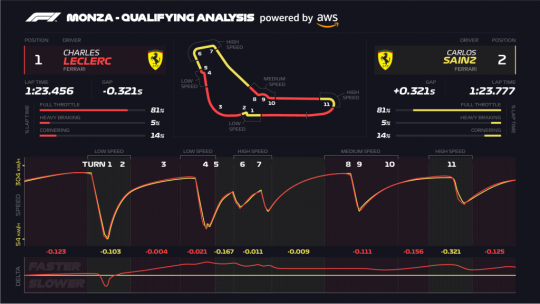
(A publicly released piece of telemetry, not exactly what the pit wall sees but similar)

(Older style F1 telemetry, still similar to today's)
So, in summery telemetry and data analysis allows teams to make informed decisions, tailor strategy, and understand both the car and driver better. Every detail is highly important to both race management and the overall development of the car.
I hope this post was informative.
Cheer,
-B
15 notes
·
View notes
Text

Realization of a cold atom gyroscope in space
High-precision space-based gyroscopes are important in space science research and space engineering applications. In fundamental physics research, they can be used to test the general relativity effects, such as the frame-dragging effect. These tests can explore the boundaries of the validity of general relativity and search for potential new physical theories. Several satellite projects have been implemented, including the Gravity Probe B (GP-B) and the Laser Relativity Satellite (LARES), which used electrostatic gyroscopes or the orbit data of the satellite to test the frame-dragging effect, achieving testing accuracies of 19% and 3% respectively. No violation of this general relativity effect was observed. Atom interferometers (AIs) use matter waves to measure inertial quantities. In space, thanks to the quiet satellite environment and long interference time, AIs are expected to achieve much higher acceleration and rotation measurement accuracies than those on the ground, making them important candidates for high-precision space-based inertial sensors. Europe and the United States propose relevant projects and have already conducted pre-research experiments for AIs using microgravity platforms such as the dropping tower, sounding rocket, parabolic flying plane, and the International Space Station.
The research team led by Mingsheng Zhan from the Innovation Academy for Precision Measurement Science and Technology of the Chinese Academy of Sciences (APM) developed a payload named China Space Station Atom Interferometer (CSSAI) [npj Microgravity 2023, 9 (58): 1-10], which was launched in November 2022 and installed inside the High Microgravity Level Research Rack in the China Space Station (CSS) to carry out scientific experiments. This payload enables atomic interference experiments of 85Rb and 87Rb and features an integrated design. The overall size of the payload is only 46 cm × 33 cm × 26 cm, with a maximum power consumption of approximately 75 W.
Recently, Zhan’s team used CSSAI to realize the space cold atom gyroscope measurements and systematically analyze its performance. Based on the 87Rb atomic shearing interference fringes achieved in orbit, the team analyzed the optimal shearing angle relationship to eliminate rotational measurement errors and proposed methods to calibrate these angles, realizing precise in-orbit rotation and acceleration measurements. The uncertainty of the rotational measurement is better than 3.0×10⁻⁵ rad/s, and the resolution of the acceleration measurement is better than 1.1×10⁻⁶ m/s². The team also revealed various errors that affect the space rotational measurements. This research provides a basis for the future development of high-precision space quantum inertial sensors. This work has been published in the 4th issue of National Science Review in 2025, titled "Realization of a cold atom gyroscope in space". Professors Xi Chen, Jin Wang, and Mingsheng Zhan are the co-corresponding authors.
The research team analyzed and solved the dephasing problem of the cold atom shearing interference fringe. Under general cases, the period and phase of shearing fringes will be affected by the initial position and velocity distribution of cold atom clouds, thus resulting in errors in rotation and acceleration measurements. Through detailed analyses of the phase of the shearing fringes, a magic shearing angle relationship was found, which eliminates the dephasing caused by the parameters of the atom clouds. Furthermore, a scheme was proposed to calibrate the shearing angle precisely in orbit. Then, the research team carried out precision in-orbit rotation and acceleration measurements based on the shearing interference fringes. By utilizing the fringes with an interference time of 75 ms, a rotation measurement resolution of 50 μrad/s and an acceleration measurement resolution of 1.0 μm/s² were achieved for a single experiment. A long-term rotation measurement resolution of 17 μrad/s was achieved through data integration. Furthermore, the research team studied error terms for the in-orbit atom interference rotation measurement. Systematic effects were analyzed for the imaging magnification factor, shearing angle, interference time sequence, laser wavelength, atom cloud parameter, magnetic field distribution, etc. It is found that the shearing angle error is one of the main factors that limits the measurement accuracy of future high-precision cold atom gyroscopes in space. The rotation measured by CSSAI was compared with that measured by the gyroscope of the CSS, and these two measurement values are in good agreement, further demonstrating the reliability of the rotation measurement.
This work not only realized the world's first space cold atom gyroscope but also provided foundations for the future space quantum inertial sensors in engineering design, inertial quantity extraction, and error evaluation.
UPPER IMAGE: (Left) Rotation and acceleration measurements using the CSSAI in-orbit and (Right) Rotation comparison between the CSSAI and the classical gyroscopes of the CSS. Credit ©Science China Press
LOWER IMAGE: Atom interferometer and data analysis with it. (a) The China Space Station Atom interferometer. (b) Analysis of the dephasing of shearing fringes. (c) Calibration of the shearing angle. Credit ©Science China Press

6 notes
·
View notes
Photo






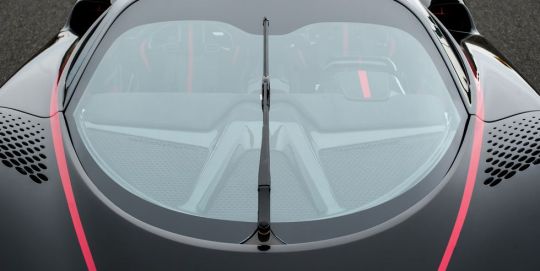
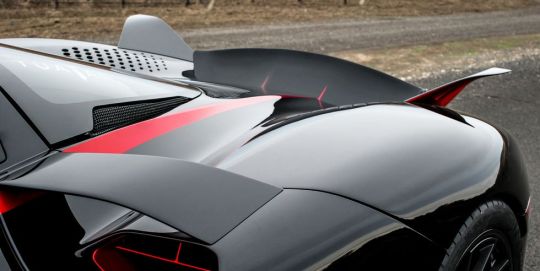


SSC Tuatara (1 of 100).
The jet fighter inspired teardrop canopy, which is suspended within the dynamic fuselage body, is complemented by vertical stabilizing fins at the rear, revealing the cars stunning speed capabilities. The streamlined design has been tuned to produce a near perfect front to rear aero balance, incredible thermal efficiency to ensure stability at all speeds up to its terminal ground velocity along with unrivaled high speed acceleration. The design of the Tuatara goes further than visual appearance. The intentional design of the body was meticulously crafted to carry the car through the air with unprecedented ease. Boasting an industry leading coefficient of drag of 0.279, the Tuatara is well balanced between unmatched aerodynamics and precision downforce at top speed.Rear static winglets, side mounted buttresses, forward static wing, and a rear active wing manipulate the smooth flowing air to distribute precision down force on the wheels. Air is also diverted to intakes that efficiently cool the powerful drive train, then expelled through perforations in the body to sustain the deliberate airflow. Downforce is systematically applied across the hypercar, providing perfect balance at all speeds.The heart of the Tuatara is an engineering masterpiece in and of itself. Years of meticulous design and engineering at SSC North America culminated into unadulterated power generated from an engine built from the ground up exclusively for the Tuatara. The smooth, balanced power produced offers both incredible performance and a unique hypercar experience. To ensure the engine met the standards of quality, performance, and durability that the hypercar market demands, SSC North America partnered with Nelson Racing Engines to fabricate and manufacture the V8 engine that powers this next generation hypercar.The Tuatara’s unprecedented power is transferred to a CIMA 7 speed transmission, integrated with a state-of-the-art Automac AMT system that operates the engagement and selection of movement in the gearbox. The system includes hydraulic driven components and sensors to produce high force engagement, position accuracy, and load control within milliseconds. The clutch and gear selection actuation are electrically operated, providing high precision and strategic operation. The core of the system is powered by a powerful automotive microprocessor, ensuring exceptional safety and performance.
70 notes
·
View notes
Text
Star Trails and Ash Rails: Space Bear Part 2
“Any registrations?” Rei asked, swinging herself into the captain’s chair and bringing up her own command console.
“Some Parishi, some Trinach. A few independent. Looks like they’re drifters. But they’re weapons hot.”
Rei watched as the ship, which either didn’t see them or didn’t care, changed course toward the enormous creature. Her console registered the firing of kinetic cannons and she tracked the course of their munitions. In one corner, she pulled up a miniature of the view screen and saw that the other ship had fired massive, tethered harpoons into the creature. Sensors registered energy undulations across the creature as it curled and turned toward the aggressor, but the harpoons stuck firm and Rei saw tethers begin to grow tighter as the other ship closed distance.
“Orders?” Vri asked and Rei made a snap decision. It was one she probably should’ve thought more about, but years behind a flight stick had taught her to trust her first judgment.
“Bring us in.” she tapped a few buttons on her console and brought weapons online.
The Stormrunner was a small ship, barely frigate class, but Rei had poured every credit she had into it. It was faster and more agile than most ships in its class, and outfitted with both shielding and armor, along with an array of weapons. Rei had only ever wanted to explore with her, but she wasn’t about to be a sitting duck in deep space.
She felt the inertia compensators adjust as power was redirected to the Stormrunner’s shields and saw the kinetic cannon targeting systems come online.
“I want a shot on those harpoon cannons Vri.” Her tone was light, but tension ran thick.
Her comm buzzed and the voice of Neim Dekker — her master of munitions — came over it.
“Cannons are live captain, and I’ve got the subsystems on standby. Whatever you’re about to punch in the throat is gonna feel it.”
Rei felt a small smile on her lips. She hadn’t even needed to alert Neim before she was on top of managing the weapons systems.
Her comm buzzed again. This time it was Tarish, her chief engineer.
“Dunno what you’re up to Cap, but engineering has your back. Karish has the core nice and stable and my team’s got redirects ready to go. Just try not to blow out the shields again, if you don’t mind. Takes a month and a bitch ton of work to get them repaired and I gotta listen to Tann bitch the whole time.”
Vri brought the Stormrunner agilely into position and Rei brought the cannons onto target. As she was about to pull the trigger, the ship’s outboard comms sounded.
“Attention unknown ship. You are about to fire on a ship independently contracted by several intergalactic governments. All of our permits are up to date and you are welcome to view them. Please power down your weapons and shove off; we are in the middle of a delicate hunt that cannot be interrupted.”
Rei let a hard smile paint her face as she ignored the request. The ship shuddered as the kinetic cannons fired, launching ferromagnetic slugs that weighed nearly 1,000 tons at sublight velocities. The first shot impacted on the hull of the other ship and Rei saw the ripple of shields disperse the energy. The second though, flew straight and true and tore its way through one of the cannons holding the harpoon tether. Even military ships couldn’t shield their weapons while they were hot.
Rei adjusted her targeting as Vri darted the Stormrunner through anti-ship fire and, after a few more hull impacts, Rei was pleased to see a round obliterate the other tether. By that time, the creature had managed to roll itself around. Rei had a good look at what she thought was its head and was pleased to see that it looked a lot like an Earth-bear’s. The thing was, she decided, a space bear. A very large, odd, space bear. She didn’t know why, but it made her smile.
Said space bear, however, was less than pleased that its snack had been interrupted and, freed from the tethers, had begun charging toward the other ship.
“Uh, Cap?”
“Yup, I see it. Clear off Vri, and try not to get us shot while you’re doing it.”
“Oh, well, as long as it’s just that little thing,” Vri responded and the ship spun and darted, inertia dampeners straining to keep the crew inside from flying around the decks.
Vri managed to weave through the fire though, and reached a safe distance just in time for Rei to watch her new friend collide with the other ship. That was the funny thing about space; it was so difficult to gauge just how fast something was moving, or just how hard it impacted something. But the shattering of shields and the rippling force that bent the other ship around the space bear’s enormous frame gave a pretty decent indication. As the creature withdrew for another attack, Rei watched energy signatures flare across her sensor report. The other ship was dropping into an emergency jump.
She watched as space warped around the ship and it limped off to some other sector to lick its wounds. Then she watched as the space bear turned its attention toward the Stormrunner.
“Cap?” Vri brought the view screen back up across the wide display of the bridge.
Rei powered down the ship’s cannons, but kept the shields hot. The space bear was moving with less purpose and speed than it had when it crumpled the other ship, but the Stormrunner was also significantly smaller than that ship had been. Vri looked over at her, waiting for an order.
“Hold here, and if it picks up speed get us out.” Rei said.
“And if it doesn’t?”
“Then let’s hope it knows its own strength, I guess.” Rei watched in awe and concern as the creature moved its incredible bulk through space with a natural grace lacked by ships she’d seen.
The Stormrunner shuddered and shook as the great head of the creature nudged it gently. The creature had slowed its approach until it stopped just within reach of the Stormrunner before slowly extending the muzzle — or muzzle shaped part at least — of its head. Alarms blared on the bridge as the ship reported the collision, but the creature stopped short of doing any actual damage and the shields held enough to keep it from actually touching the hull. Besides, Rei was no expert, but she was pretty sure it was just saying thanks. After all, it could absolutely have destroyed them if it so desired.
Its communication done, the space bear slowly turned itself back toward the star and ignored the Stormrunner. Rei got up from her chair and smiled at Vri.
“See, everything’s fine.”
“Hey Cap, next time you decide to let a giant space bear fucking nudge my ship, warn me beforehand.”
“I’ll do that Vri,” Rei laughed. “Go ahead and get us outta here. Let me know if anything else happens.”
“Oh trust me, I’d much rather you be responsible for doing all the shooting of people,” Vri muttered and set a course. Rei grinned as she left the bridge. Later, she might regret shooting at the unknown ship, but for now, she’d made a new friend, and that was enough.
2 notes
·
View notes
Text
Gemini is an open-source robotics platform for R&D, education, and personal development, with a smart design and a high price-performance ratio. Gemini combines the concepts of AGV and AMR robotics, based on a two-wheeled Differential Velocity Mechanism, and integrates more than 10 sensors such as laser radar, depth camera, ultrasonic array, microphone array, monocular array, etc., as well as rich computing power from the NVIDIA. The rich ROS/ROS2 software packages and simulation environment for beginner developers allow users to easily develop robot systems, positional guidance systems, and other systems. Users can easily develop robotic systems, positioning and navigation, audio-visual, machine learning, storage, and logistics functions.
2 notes
·
View notes
Text


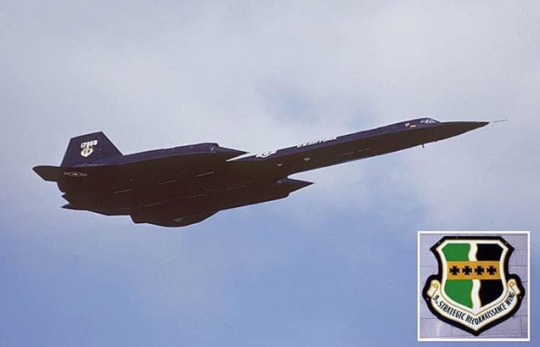

We spoke to pilot BC Thomas, SR 71 pilot , about life in the most exciting seat in the world.
What was the closest they got to shooting down an SR-71?
A few miles, maybe. The last known missile launch against the SR-71 was on August 25, 1981, when Maury Rosenberg (pilot) and Ed McKim (RSO) were flying against North Korea. Maury reported that he thought the explosion was a few miles away, but judging distances 15 miles above the earth is difficult because there is nothing to compare. Although the SR-71 had been attacked many times, especially over Vietnam during that war, nothing ever hit an SR-71 aircraft.”
Tell me something I don’t know about the aircraft.
“Perhaps the extent of the ground training we had before our first flight and for recurring training throughout our time flying the SR-71, but that is not airplane specific. For the plane, I will tell you what two aspects of the aircraft most surprised me.
The astro-inertial navigation system (ANS), once aligned, could automatically track 61 stars from a catalog, identifying their position, and through a complicated algorithm, quickly compute the aircraft’s altitude, attitude, speed, ground track, and continually update the aircraft’s position while directly controlling the aircraft’s ground track (if engaged by the pilot) and providing automatic pointing and control of the cameras and sensors. Even at maximum speed, the ANS could provide course guidance within a quarter of one mile. Unbelievable technology before the advent of the Global Positioning System (GPS).
I knew that the faster an aircraft flies, the warmer it becomes, relative to the outside air temperature, but I was quite surprised how hot the aircraft would be at Mach 3 and above. The temperature rise is due to air friction; i.e., each air molecule, when hit by an object traveling around 2,000+ mph, causes an immediate and dramatic heat rise, the rise being a function of the square of the velocity, like the kinetic energy formula KE = 1/2 (mass) times velocity-squared. Bottom line: the temperature of the windshield only 2.5 feet from my face would be 621 degrees F, which is approximately the temperature of an oven during the cleaning cycle. This was one of the greatest challenges to the designers of the SR-71: to keep the cockpit, mission bays, and tires, cool enough. Other problems: invent fuel, hydraulic fluid, sealants, and oil to withstand that kind of heat for hours at a time and remain functional.”
Interviews that Hush-kit had with BC Thomas SR 71 pilot. This is just part of a long interview that he did. Also, I watched his interviews on YouTube and highly recommend them. Linda Sheffield Miller
@Habubrats71 via Twitter


3 notes
·
View notes
Text
Miami Spec Mansion Lists at $75M, Ultra-Luxury Bids Loom

Former MLB Star Alex Guerrero Debuts $75 Million Waterfront Estate on Millionaire's RowFormer Los Angeles Dodgers infielder Alex Guerrero has introduced a monumental $75 million spec mansion on Miami Beach's ultra-exclusive North Bay Road.This debut represents one of the boldest luxury real estate moves in South Florida's volatile market.The sprawling 10,250-square-foot waterfront estate is priced at approximately $7,300 per square foot. It stands out as one of the most expensive residential properties in the region.Guerrero's transition from professional baseball to high-stakes real estate mirrors broader luxury trends reshaping Miami's elite property landscape.The former athlete acquired the North Bay Road land for $13.6 million in 2023.Guerrero aims for a significant return on his investment, targeting a fivefold increase within just two years. The property features an innovative sensor-activated waterfall at the entrance to its massive 18-car garage, adding dramatic flair to the ultra-luxury amenities. The expansion of luxury sales in markets such as Miami has caused an increase in overall property values, further enhancing the potential for substantial returns.His AG 07 Investments LLC has already marked success with a $17.2 million sale on Palm Island in 2023. This establishes his credibility in Miami's ultra-luxury real estate sector.The seven-bedroom mansion boasts features catering to ultra-high-net-worth buyers.These include three specialized kitchens, an 18-car garage, and docking capabilities for 90-foot yachts, offering uncompromising waterfront luxury.Architectural Marvel Features 18-Car Garage, Three Kitchens, and 90-Foot Yacht DockGuerrero's $75 million waterfront mansion redefines luxury with infrastructure tailored for ultra-wealthy collectors and entertainers.This estate pushes beyond conventional boundaries with its unique design.The property's standout feature is an extraordinary 18-car garage complex. It sets new benchmarks for luxury garages in Miami's elite market.The facility is divided into two sections: a massive 15-car underground bay and a three-car climate-controlled space above ground. This innovative design caters to enthusiasts and collectors.To support lavish entertaining, the estate includes three strategically positioned kitchens.There are two indoor spaces and a fully equipped outdoor catering kitchen for ultimate convenience. Cutting-edge real estate apps can be immensely beneficial for tracking investment opportunities in high-value properties like this.A private dock elevates waterfront living, designed to accommodate a 90-foot yacht. This feature offers peak luxury for owners and guests.The master suite, spanning 1,500 square feet, offers unparalleled luxury.It includes a private cold plunge, adding a touch of indulgence.Entertainment zones are versatile, boasting multiple indoor and outdoor spaces.These areas are seamlessly integrated with an infinity pool, enhancing the leisure experience.Positioned on the exclusive North Bay Road, the property joins the ranks of celebrity-owned estates in one of Miami's most coveted neighborhoods.Miami Beach Ultra-Luxury Market Sees Celebrity-Driven Development TrendsSeveral high-profile celebrity acquisitions have fundamentally altered Miami Beach's ultra-luxury real estate scene. These deals have created unprecedented demand patterns, reshaping market dynamics in the region's exclusive waterfront enclaves.Celebrity endorsements have elevated South Beach properties into coveted assets. Star power drives pricing premiums and accelerates sales velocity, reaching heights traditional marketing channels can't replicate.The social media exposure from high-profile residents generates global visibility. This exposure creates a buzz that attracts international buyers, eager to invest in the glamour.Luxury branding strategies now incorporate celebrity associations as core marketing elements. International buyers increasingly target neighborhoods where entertainment industry figures establish homes.
Market indicators reveal significant celebrity influence across segments. High-profile purchases instantly boost property values in surrounding areas.Social media posts showcasing luxurious amenities can prompt international buyer inquiries within hours. Developments endorsed by celebrities often command premium pricing before construction even completes.Star residents attract additional high-net-worth individuals. These buyers seek exclusive community access, further enhancing the allure of these neighborhoods.The importance of community and relationships has been crucial in maintaining Miami Beach's appeal, similar to strategies used by successful real estate investors like Mackenzie Grate, who prioritize network building over immediate sales.Entertainment industry connections create secondary market opportunities. Luxury service providers benefit from the influx of high-profile residents and their specific needs.This celebrity-driven momentum reinforces Miami Beach's status as the nation's premier ultra-luxury destination. The city continues to capture the attention of celebrities and high-net-worth individuals alike.AssessmentGuerrero's $75 million waterfront estate is a game-changer for Miami Beach's luxury residential scene. This signals an unprecedented shift in the market dynamics.Celebrity-driven developments are saturating Millionaire's Row. Spec mansions are now exceeding traditional price thresholds, creating a new norm.The mix of architectural excess and speculative pricing leads to volatile market conditions. Ultra-luxury segments are feeling the impact.Industry professionals face increased pressure as inventory levels soar. Conventional valuation models are being challenged.Miami is transforming into a celebrity enclave. This fundamentally alters investment strategies and market dynamics across South Florida's premium waterfront corridor.
0 notes
Text
Data Driven Strategy Consulting
Data Driven Strategy Consulting: Transforming Business with Intelligence and Insight
In today’s hyper-competitive and rapidly evolving business environment, intuition and experience alone are no longer sufficient to drive sustained success. The companies leading their industries have something in common—they make decisions based on data. This shift has given rise to the importance of data driven strategy consulting, a discipline that blends data science, analytics, and business acumen to develop actionable strategies rooted in evidence rather than guesswork.
From marketing to supply chain management, from financial planning to customer experience optimization, every business function can benefit from a more data-informed approach. But understanding how data driven strategy consulting works and why it matters is essential for any organization aiming to outperform its competitors.
Understanding Data Driven Strategy Consulting
Data driven strategy consulting is the practice of using structured and unstructured data to formulate, guide, and validate strategic business decisions. It relies on advanced analytics tools, machine learning models, and a deep understanding of both internal business operations and external market dynamics.
At its core, this consulting approach is about aligning data insights with business goals. It’s not just about collecting data—it’s about interpreting it effectively, identifying patterns, and uncovering opportunities that might otherwise remain hidden.
Consultants in this space function as both analysts and strategists. They bring together technical skill sets such as statistical modeling, data visualization, and predictive analytics with strategic capabilities like competitive analysis, market positioning, and operational optimization.
The Role of Big Data in Strategy Development
Modern businesses are inundated with data—from web traffic logs and social media metrics to customer feedback and IoT sensor outputs. Big data encompasses the massive volume, velocity, and variety of this information, and it forms the backbone of data driven strategy consulting.
The key is turning this raw data into business intelligence. This includes:
Descriptive Analytics: Understanding what has happened through historical data.
Diagnostic Analytics: Identifying why something happened by uncovering correlations and root causes.
Predictive Analytics: Forecasting future outcomes using trends and machine learning models.
Prescriptive Analytics: Recommending actions to achieve desired outcomes based on the predictions.
By combining these types of analytics, businesses can move from reactive to proactive planning, spotting trends before they become problems—or opportunities before they are obvious.
Why Businesses Need Data Driven Strategy Consulting
Informed Decision-Making
Decision-making under uncertainty can be costly. By leveraging data, organizations gain clarity. Data driven strategy consulting allows leaders to validate assumptions, test hypotheses, and reduce risk in strategic planning.
Increased Agility
Markets change fast. Consumer behaviors shift, competitors evolve, and regulations emerge. Data-driven insights provide the agility to pivot quickly and accurately, ensuring businesses remain responsive rather than reactive.
Customer-Centric Innovation
Consumer expectations are more dynamic than ever. Using data to map customer journeys, segment audiences, and personalize offerings leads to better user experiences. Strategy consulting built on this data helps brands innovate in meaningful, impactful ways.
Operational Efficiency
Identifying inefficiencies in workflows, redundancies in supply chains, or opportunities for automation can dramatically improve bottom-line performance. Data driven strategy consulting highlights these insights with clarity.
Competitive Advantage
Businesses that leverage their data assets to guide decisions consistently outperform those that do not. In industries where margins are tight and disruptions are frequent, data becomes the differentiator.
Key Components of Data Driven Strategy Consulting
To fully leverage this approach, several elements must be in place:
1. Clear Business Objectives
Data without direction is noise. Consultants work with leadership to define specific, measurable goals. Whether it's entering a new market, improving retention, or increasing margin, having a clear target shapes the analysis.
2. Robust Data Infrastructure
A strong digital backbone is essential. This includes clean, integrated, and accessible data stored in secure systems. Cloud-based platforms, data lakes, and enterprise resource planning (ERP) integrations play a crucial role in consolidating and managing data.
3. Analytical Rigor
The use of advanced analytics ensures that the insights uncovered are not only descriptive but predictive and prescriptive. Data modeling, clustering, regression analysis, and AI tools are often used to uncover patterns and simulate different business scenarios.
4. Cross-Functional Collaboration
Data driven strategy consulting doesn’t exist in a silo. It demands collaboration across marketing, finance, operations, IT, and HR to capture a holistic view of the business and implement insights organization-wide.
5. Continuous Monitoring and Adaptation
A strategy should never be static. With real-time data, businesses can track the effectiveness of strategic decisions and adjust as needed. Dashboards and KPIs keep the organization aligned and aware of progress.
Data Ethics and Governance in Strategy
With great data comes great responsibility. Ethical considerations are paramount in data driven strategy consulting. This includes data privacy, compliance with regulations such as GDPR and CCPA, and transparency in data sourcing and usage.
Strong data governance ensures that data quality, security, and accessibility are maintained. Strategy consultants help businesses build these frameworks, fostering trust and accountability in how data is handled.
Real-World Applications Across Industries
Data driven strategy consulting finds applications in nearly every sector:
Retail and E-Commerce: Optimizing inventory, pricing strategies, and customer loyalty programs through purchasing data and behavioral analysis.
Healthcare: Enhancing patient care and resource allocation by analyzing treatment patterns and operational data.
Finance: Managing risk and fraud detection using real-time transactional data and machine learning models.
Manufacturing: Improving supply chain logistics and reducing downtime through predictive maintenance and process optimization.
Hospitality: Personalizing guest experiences and optimizing staffing using booking patterns and sentiment analysis.
These examples showcase the versatility and transformative power of data in strategic decision-making.
Challenges in Adopting Data Driven Strategy
Despite the benefits, there are barriers to implementation:
Data Silos: Many organizations struggle with fragmented systems that prevent unified data analysis.
Talent Shortage: There is high demand for professionals skilled in both data science and business strategy.
Change Management: Shifting from intuition-led to data-led decision-making can face resistance from leadership and staff alike.
Technology Gaps: Not all businesses have access to the tools or platforms needed to execute a robust data strategy.
However, with the right consulting guidance, these challenges can be overcome through phased implementation, upskilling, and strategic investment.
The Future of Data Driven Strategy Consulting
As AI and machine learning continue to evolve, the possibilities for data driven strategies will only expand. Natural language processing, real-time analytics, and automation will further enhance decision-making capabilities.
In the near future, we can expect to see:
Deeper Personalization at Scale: Hyper-targeted campaigns and customer experiences using micro-segmentation.
Predictive Operations: Businesses running simulations and stress-tests for strategic plans before implementation.
AI-Augmented Leadership: Decision-makers equipped with tools that present real-time recommendations based on evolving data.
These trends point to a future where strategy is no longer developed in annual boardroom meetings but dynamically adjusted in real time, based on constant data feedback.
Conclusion
Data driven strategy consulting is more than just a buzzword. It’s a mindset shift—a commitment to making smarter, faster, and more accurate decisions based on facts, not feelings. In a world where data is the new currency, businesses that learn to interpret and act on that data will be the ones that thrive.
Whether you’re a startup looking to carve out market share or an established enterprise seeking innovation, embedding data into your strategic foundation is no longer optional—it’s essential. The consultants who can merge analytics with business acumen are not just supporting growth; they are defining the future of strategy.
1 note
·
View note
Text
Advancement Of Water Pumping Technology Throughout History
Water pumps are important devices that are used widely as a way to move water in the residential, commercial, and industrial sectors. Through providing the home with a continuing water supply, to providing support for large-scale agricultural irrigation and fluid transfers involved in industrial processes, pumps and pumping systems play important roles in how water is managed in our current age.

Variants of Water Pumps
Water pumps are categorized according to their applications, and the water type. Common types of pumps are:
Condensate Pumps: Those that collect and transport condensate in steam systems, and are most commonly used in the industrial and HVAC industry.
Groundwater Pumps: Used to transfer untreated water from the ground and are commonly used in wells and irrigation.
Potable Water Pumps: Designed to transfer water that is safe for human consumption, and is made and used to abide by health authority parameters.
Salt Water Pumps: Designed to be used in saline water to be used in the sea or desalination.
Core Technologies and Applications
The main water distribution system pump technologies are positive-displacement pumps and centrifugal pumps. The most common type of centrifugal pumps use a rotating impeller to impart velocity and pressure to the water and are suited best to general water movement and distribution. Positive-displacement pumps are used in processes requiring precise dosing or high-pressure operations, for example, with chemical treatment process.
Vertical turbine and submersible pumps are also used widely for specific applications like deep well pumping and intake from water supplies.
Smart Water Pumps and Automation
The technology has now reached the level of integrating smart controls and automation. Water pump control systems today use sensors, controllers and the ability to connect and monitor all of this in real time - using intelligent operations. These systems can control and change the operational capacity of all or part of the pump automatically based on water level, pressure, and flow rates for increased energy efficiency and increased reliability. Smart pumps have remote access, using Internet of Things (IoT) sensors to monitor performance and predictive maintenance, which reduces the human aspect they certainly need to manage as well as the amount of energy consumed by the pumps.
Choice of Proper Water Pump
Proper water pump choice depends on several factors:
Nature of water being processed (clear, potable, salt, etc.)
Requirement for pressure and flow rate
Environmental use (residential, commercial, industrial)
Automation needs and energy efficiency
For example, a high-powered, high-volume pump is needed for tough industrial applications, whereas a low powered, small capacity pump may be adequate for residential purposes.
Conclusion
Water pumps support the transfer of liquids for millions of application means, from drinking water, to powering some industry's most vital processes.With the advent of smart technology, and with the capacity to drive many sophisticated pump controls automatically, today's pumps are more efficient, more dependable and more controllable than ever before. If you select the right pump for your application, it will optimize your performance and efficiency with the optimum cost savings over the long term and set you on a sustainable water usage path.
For owners and operators of businesses requiring efficient water pump solutions, scanning the full range of pumps and working with knowledgeable suppliers will change the way you operate and introduce opportunities for successful operations for many years to come.
0 notes
Text


Rug Warrior II (1993) by Joseph Jones (iRobot) and Anita Flynn (MIT AI Laboratory), MA. “The tank” has the same electronics and sensor suite as the first Rug Warrior, but its mechanical base is built from a LEGO tracked locomotion system. The control board on top contains a Motorola MC68HC11A0 8-bit microcontroller. “In open-loop control, there is no feedback from the motors, telling the robot’s program how fast the wheels are turning or how far the robot has gone. Rather, the motors are just given different commanded voltages. But depending on terrain, surface obstacles, slippage in wheel contacts, or load on the robot, the commanded voltages do not necessarilly imply particular speeds. To implement a true velocity- or position-control algorithm, the robot needs sensors on the wheels. … Such feedback enables what are known as closed-loop control algorithms. … The simple control loop we will use on Rug Warrior [is] called a P-I controller, for proportional-integral controller.” – Mobile Robots: Inspiration to Implementation, by Joseph Jones and Anita Flynn.
29 notes
·
View notes
Link
#AI#defensetechnology#Europeansecurity#Helsing#militaryinnovation#NATO#strategicautonomy#venturecapital
0 notes
Text
Fibre Optic Gyroscope Market Emerging Trends Shaping Navigation Technology
The fibre optic gyroscope market is undergoing significant transformation driven by rapid technological advancements, increasing demand for precise navigation, and growth in autonomous systems. FOGs, which are used to measure angular velocity using the interference of light, have become a preferred solution over mechanical gyroscopes due to their higher reliability, compact design, and immunity to electromagnetic interference. As global industries seek more advanced inertial navigation systems, the FOG market is positioned for substantial growth, influenced by emerging trends across aerospace, defense, marine, and industrial automation sectors.
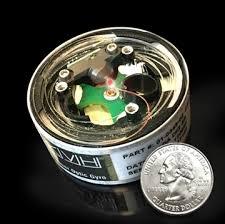
Rising Demand for Autonomous Navigation Systems
One of the most prominent trends in the fibre optic gyroscope market is the surging demand for autonomous vehicles and navigation systems. Self-driving cars, unmanned aerial vehicles (UAVs), and autonomous underwater vehicles (AUVs) require precise motion sensing and orientation tracking. FOGs offer the required accuracy and durability to support these platforms. This trend is particularly strong in the defense sector, where unmanned ground and aerial systems rely heavily on gyroscopic inputs for mission-critical operations in GPS-denied environments.
Integration with AI and Sensor Fusion Technologies
The integration of fibre optic gyroscopes with artificial intelligence (AI) and sensor fusion platforms is accelerating. Sensor fusion combines data from multiple sensors such as accelerometers, magnetometers, and FOGs to create a more accurate and reliable navigation system. When enhanced with AI algorithms, these systems can predict and adjust navigation paths dynamically. This development is crucial for sectors such as robotics, aerospace, and space exploration, where even minor errors in orientation can lead to mission failure.
Advancements in Miniaturization and MEMS Integration
Miniaturization of FOG technology has become a key focus area, enabling its application in compact and mobile platforms. Recent trends highlight the convergence of microelectromechanical systems (MEMS) with fibre optic gyroscopes, allowing for the development of hybrid gyros that combine the precision of FOGs with the size and cost-effectiveness of MEMS. This innovation is opening up new opportunities in consumer electronics, wearable technology, and portable navigation devices.
Growing Adoption in Space and Satellite Applications
The space industry is increasingly adopting fibre optic gyroscopes for satellite attitude control and interplanetary missions. As space agencies and private companies ramp up satellite launches, there is an intensified need for lightweight and highly reliable orientation systems. FOGs provide excellent long-term stability and resistance to harsh environments, making them ideal for orbiting satellites, launch vehicles, and deep space missions. This trend is expected to grow with the expansion of global satellite constellations and interplanetary exploration initiatives.
Rising Emphasis on Defense Modernization
Globally, countries are investing heavily in defense modernization, and fibre optic gyroscopes are playing a vital role in this transformation. From missile guidance to submarine navigation and armored vehicle stabilization, FOGs are essential components of next-generation defense equipment. The increased use of drones and advanced munitions has further bolstered demand, with militaries requiring reliable navigation tools in GPS-compromised conditions. FOGs meet this need due to their ability to function accurately without external signals.
Increasing Commercial Aviation Applications
In commercial aviation, FOGs are being increasingly used in inertial navigation systems (INS) for both fixed-wing and rotary aircraft. With the growth in global air traffic and the demand for more efficient and safer aircraft, aviation manufacturers are incorporating high-precision navigation systems. Fibre optic gyroscopes are helping ensure reliable flight control, especially under dynamic or turbulent conditions. As air travel rebounds post-pandemic and new aircraft technologies emerge, FOGs are expected to see expanded deployment.
Environmental and Energy Industry Utilization
Another emerging application area for FOGs is in the energy sector, particularly in oil and gas exploration and pipeline monitoring. In these environments, the ability to monitor orientation and rotation accurately is critical. FOG-based systems are being deployed for directional drilling, borehole surveying, and geophysical measurements. Their ruggedness and reliability in extreme conditions make them a valuable asset for such industries, a trend that is expected to strengthen with global energy demand.
Technological Advancements and R&D Investment
Continuous innovation is fueling the growth of the FOG market. Companies are investing in advanced research and development to enhance performance, reduce costs, and expand the application scope. Innovations in optical fiber materials, laser sources, and signal processing techniques are leading to better performance metrics in terms of bias stability, noise reduction, and temperature sensitivity. As a result, FOGs are becoming more accessible for commercial and industrial applications.
Conclusion
The fibre optic gyroscope market is evolving rapidly, with emerging trends pointing to a broader application landscape and improved technological capabilities. From autonomous vehicles and AI integration to space exploration and defense modernization, FOGs are becoming indispensable components in critical navigation systems. With ongoing innovation and increased adoption across sectors, the future of the FOG market looks promising, offering robust opportunities for stakeholders and setting new benchmarks in precision sensing.
0 notes
Text

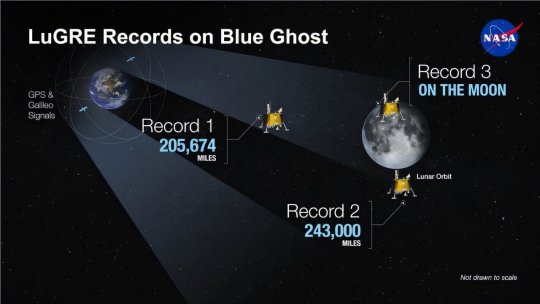
NASA successfully acquires GPS signals on moon
NASA and the Italian Space Agency made history on March 3 when the Lunar GNSS Receiver Experiment (LuGRE) became the first technology demonstration to acquire and track Earth-based navigation signals on the moon's surface.
The LuGRE payload's success in lunar orbit and on the surface indicates that signals from the GNSS (Global Navigation Satellite System) can be received and tracked at the moon. These results mean NASA's Artemis missions, or other exploration missions, could benefit from these signals to accurately and autonomously determine their position, velocity, and time. This represents a steppingstone to advanced navigation systems and services for the moon and Mars.
"On Earth we can use GNSS signals to navigate in everything from smartphones to airplanes," said Kevin Coggins, deputy associate administrator for NASA's SCaN (Space Communications and Navigation) Program. "Now, LuGRE shows us that we can successfully acquire and track GNSS signals at the moon. This is a very exciting discovery for lunar navigation, and we hope to leverage this capability for future missions."
The road to the historic milestone began on March 2 when the Firefly Aerospace's Blue Ghost lunar lander touched down on the moon and delivered LuGRE, one of 10 NASA payloads intended to advance lunar science. Soon after landing, LuGRE payload operators at NASA's Goddard Space Flight Center in Greenbelt, Maryland, began conducting their first science operation on the lunar surface.
With the receiver data flowing in, anticipation mounted. Could a moon-based mission acquire and track signals from two GNSS constellations, GPS and Galileo, and use those signals for navigation on the lunar surface?
Then, at 2 a.m. EST on March 3, it was official: LuGRE acquired and tracked signals on the lunar surface for the first time ever and achieved a navigation fix—approximately 225,000 miles away from Earth.
Now that Blue Ghost is on the moon, the mission will operate for 14 days providing NASA and the Italian Space Agency the opportunity to collect data in a near-continuous mode, leading to additional GNSS milestones. In addition to this record-setting achievement, LuGRE is the first Italian Space Agency developed hardware on the moon, a milestone for the organization.
The LuGRE payload also broke GNSS records on its journey to the moon. On Jan. 21, LuGRE surpassed the highest altitude GNSS signal acquisition ever recorded at 209,900 miles from Earth, a record formerly held by NASA's Magnetospheric Multiscale Mission. Its altitude record continued to climb as LuGRE reached lunar orbit on Feb. 20—243,000 miles from Earth. This means that missions in cislunar space, the area of space between Earth and the moon, could also rely on GNSS signals for navigation fixes.
Traditionally, NASA engineers track spacecraft by using a combination of measurements, including onboard sensors and signals from Earth-based tracking stations. The LuGRE payload demonstrates that using GNSS signals for navigation can reduce reliance on human operators because these signals can be picked up and used autonomously by the spacecraft, even as far away as the moon.
The LuGRE payload is a collaborative effort between NASA's Goddard Space Flight Center in Greenbelt, Maryland, the Italian Space Agency, their industry partner Qascom, and Politecnico di Torino.
TOP IMAGE: Firefly’s Blue Ghost lander captured its first sunrise on the Moon, marking the beginning of the lunar day and the start of surface operations in its new home. Credit: Firefly Aerospace
LOWER IMAGE: An artist’s concept of the LuGRE payload on Blue Ghost and its three main records in transit to the Moon, in lunar orbit and on the Moon’s surface. Credit: NASA/Dave Ryan
5 notes
·
View notes